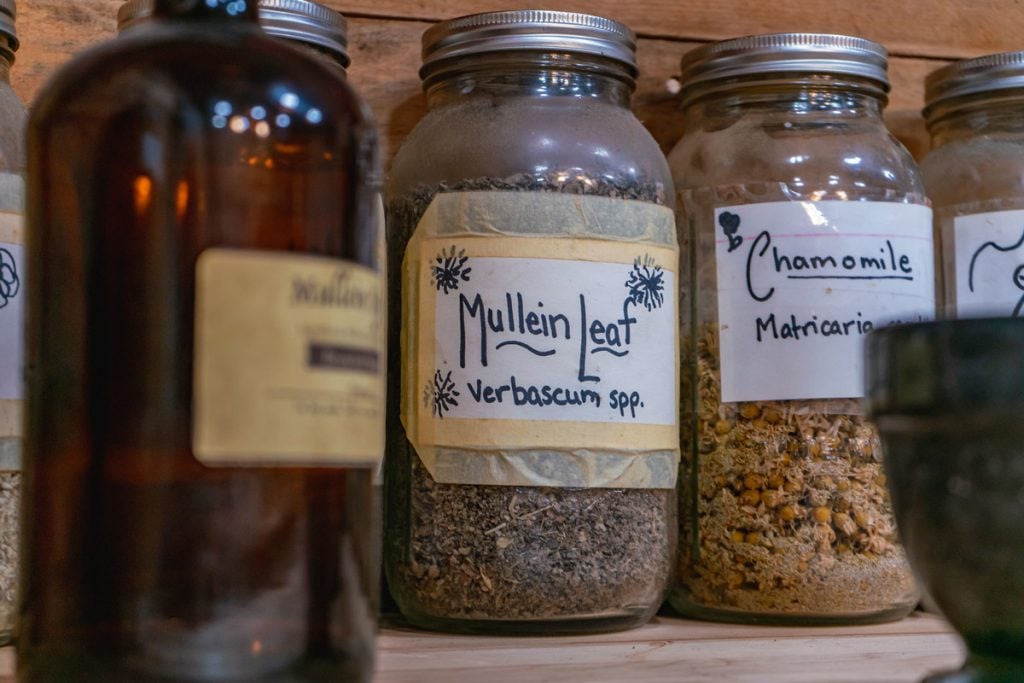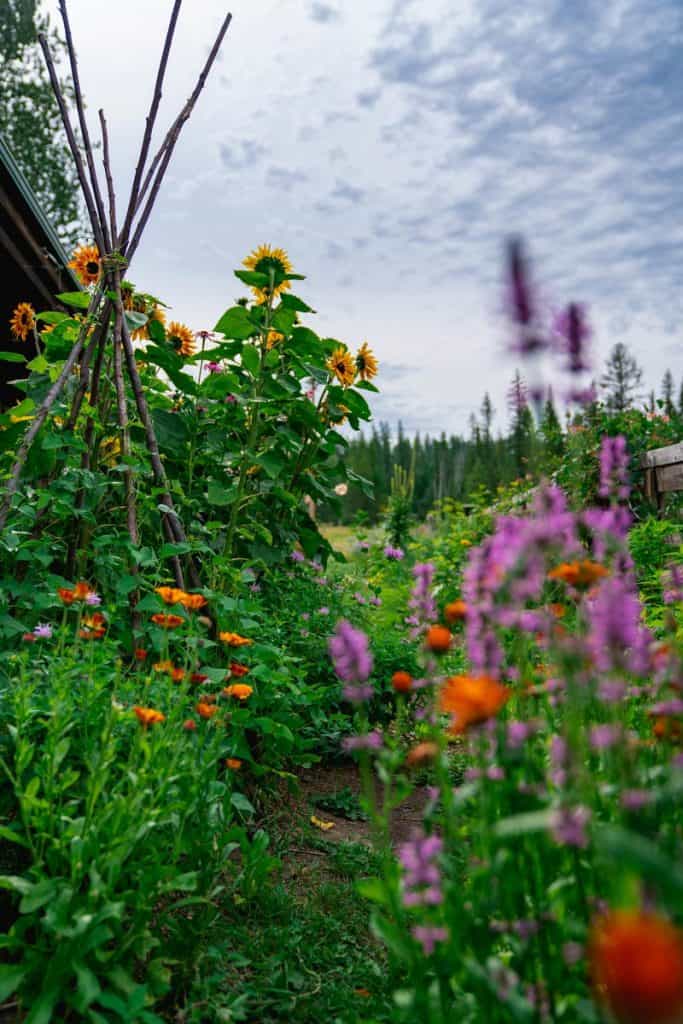Join me and guest Mary Colvin as we discuss building and maintaining a home apothecary. We’ll discuss what it is, the tools necessary to build a well-stocked apothecary, some common terms, and recommended herbs to start with.

It’s important to note that I am not a certified medical practitioner. This post is not intended to diagnose or treat but is for informational purposes only. Please contact your medical professional before introducing new herbal remedies into your wellness routine.
Why I Love Herbs
It’s no surprise that I love herbal medicine and making my own home remedies like my homemade headache balm, immune-boosting elderberry syrup, and simple remedies for colds and congestion.
I’ve written about how to start using herbs, designing and growing your own cottage garden filled with medicinal herbs, and even how to use herbs in an emergency. You can check out my herb archives for dozens of posts on various herbs and remedies.
Sadly, the majority of the world is used to a pharmaceutical point of view when it comes to medications and dealing with ailments. Rather than dealing with the source of the issue, we’re trained to reach for over-the-counter medications to relieve our specific symptoms.
Herbal medicine is slightly different. We learn how the herbs work with our bodies to help improve our natural systems and, at the same time, relieve the root issue that is causing our symptoms.

About Mary Colvin
Mary has been working with herbs since 2008. Her journey into herbalism began as a means to heal herself. She was in severe pain for a couple of years until an MRI was ordered, and the doctors diagnosed her with degenerative disks, herniated discs, and sciatica.
After surgery, which did alleviate the pain on the sciatic nerve, it created a new pain in her fascia. The pain specialist said she would be in pain for the rest of her life.
Mary refused that diagnosis and went home to find more solutions. This started her on a course of natural healing with herbs. It didn’t take long to find out that she could connect with plants to help heal her body.
In 2011, Mary began helping clients with a focus on training others in herbalism to help them feel comfortable working with the plants, show them the best course of training for them personally, and help them navigate their study of herbalism.
What Does Apothecary Mean?
Apothecary is an archaic term that was used regularly in the past. It could mean a person or a place that made and sold herbal medicine. Many people today associate apothecary with a pharmacist or a chemist, though neither one of them use that term.
The easiest way to think of an apothecary is anything having to do with herbs or herbal preparations.

Why is a Home Apothecary Needed?
A home apothecary is just one way that preparedness helps protect our families. There are many reasons why a home apothecary is a phenomenal asset:
- Healthcare Availability – We don’t know if our current healthcare or modern medicine will always be available to us. During the pandemic, we saw medication shortages firsthand.
- Cost – The cost of healthcare and over-the-counter medications are expensive. If we’re all taking care of the majority of our healthcare at home, the costs for these modern medicines/methods will eventually go down, making them more affordable for those who truly need them.
- Overtreatment – The allopathic medical community is grossly overtreating patients. Many ailments go away on their own without medications and proper rest and recuperation. However, the healthcare system is continuing to prescribe unnecessary medications. It’s said that over 30% of healthcare costs are due to these overtreatments. (Source)
- Faster Treatment – When we have ready-made remedies on the shelf to treat or alleviate the first signs of symptoms, we end up saving our family a lot of money and unnecessary doctor’s visits. If you can treat symptoms right at the onset (e.g., the tiniest tickle in the throat, stuffy/runny nose, headache, etc.), those immediate remedies are most effective and often prevent a minor issue from turning into something more severe.
- Prevention is the Best Cure – Finally, prevention is the best cure. When we live a healthy lifestyle and eat healthy whole foods, we’re setting ourselves up for good health and a strong immune system. Check out more ways to naturally boost your immune system here.

Tools Needed for an Apothecary
There are some common household items that make having a home apothecary much easier to use! The best part is you likely have many of these already lying around your kitchen:
| Marc | The herb that’s being used. It’s what’s left after maceration and extraction into the menstruum. |
| Menstruum or Solvent | This is the liquid used to extract an herb. It could be water, alcohol, vinegar, glycerin, honey or a combination of these. |
| Pots & Pans | Great for steeping, extracting, heating, creating a double-boiler, etc. |
| Cheesecloth | Cheesecloth is fantastic for straining herbs. You can also use something reusable such as a fine mesh colander/strainer or even a clean tea towel. |
| Mortar and Pestle | A mortar and pestle is a fantastic tool for grinding herbs into a powder. You can even have a dedicated coffee grinder used only for herbs. |
| Containers | Having proper containers to elongate the shelflife of your herbs is key! Reach for dark amber glass and store your apothecary items out of direct sunlight in a temperature-controlled room. |

Which Herbs to Keep in Your Apothecary
I asked Mary which herbs she thinks are best to start with if someone is ready to start building their home apothecary. She said it’s a very individual approach, and it will be based on your family’s needs and your environment.
That being said, the best herbs to start with are the herbs already growing around you. By finding the herbs that are growing right in your backyard, you can research each one and begin to learn how to use those herbs to make herbal preparations and start implementing them with your family. You can learn more about my favorite herbs to forage in your backyard here.
Beyond that, think about your unique needs. Do you get headaches often and want a good headache remedy? What other ailments might arise that you’d want a remedy for? How about an herbal remedy for sprains and strains, stings, seasonal allergies, a stomach ache, or natural cold remedies?
Building up your first-aid kit is also important. Knowing what to do when an emergency happens might make you stock certain herbs or tinctures to have at the ready.

Mary’s Favorite Herbs
I had to ask Mary what her favorite herbs are to keep in her home apothecary. She, like me, struggled to come up with just a few! Below are the herbs she tends to reach for most often:
- Wild Bergamot – This is also sometimes called Sweet Leaf or Bee Balm.
- Violets – Mary uses violets for the respiratory and nervous systems as a cooling and moisturizing herb for inflammation and irritated tissue.
- Yarrow – Mary considers this a great first-aid herb as it helps stop bleeding.
- Ground Ivy (Creeping Charlie) – Great for soothing inflamed mucous membranes. Helpful for head colds (especially congestions in ears). Good for bronchitis and viral pneumonia, as a cough remedy and for kidney and lung disorders. (Source)
- Burdock Root & Dandelion – For the liver and kidneys. (Source)
- Mullein – Mary calls this her multi-functional herb, and she reaches for it often for many different formulas for pain, the lymph system, etc. (Source)
You can check out these posts on my favorite 15 medicinal herbs to grow and their uses and herbs for every season (kitchen, garden & apothecary).

When is Your Apothecary Complete?
Mary says the apothecary can be completed when you’ve gone through all your circumstances or situations and have a remedy for each. However, when I asked her if an apothecary is ever truly finished, she said no!
I couldn’t agree more. There are always more herbs to grow and learn about. Furthermore, you or a family member may have new situations or ailments that arise that require a new remedy or herb.

Standard Dosing for Herbs
When thinking about dosing, it’s important to understand that the standard dose is based on a 150-pound adult. A standard dose of an herb is generally 30 drops taken three times per day. If you’re dealing with a 50-pound child, you’d just divide that standard dose by three. So give 10 drops three times per day. Adjust, as needed, by weight.
Sometimes, for more mild situations, you can start at lower doses and work up to get the desired results (or action) from the herb. Other times, you may have a severe situation or be coming down with an illness fast and want to increase the dosage to kickstart the herbal action.

Where to Learn More
If you’ve enjoyed this podcast interview with Mary and want to learn more, you can visit her website, The Herbalist Mentor. Also, be sure to check out her book, The Herbalist’s Guide: How to Build and Use Your Own Apothecary and check out her herbalist mentor membership or find membership packages that suit your needs on her website.
Be sure to follow Mary on Instagram and Facebook and tune in to her Herbology Talk Podcast.



















